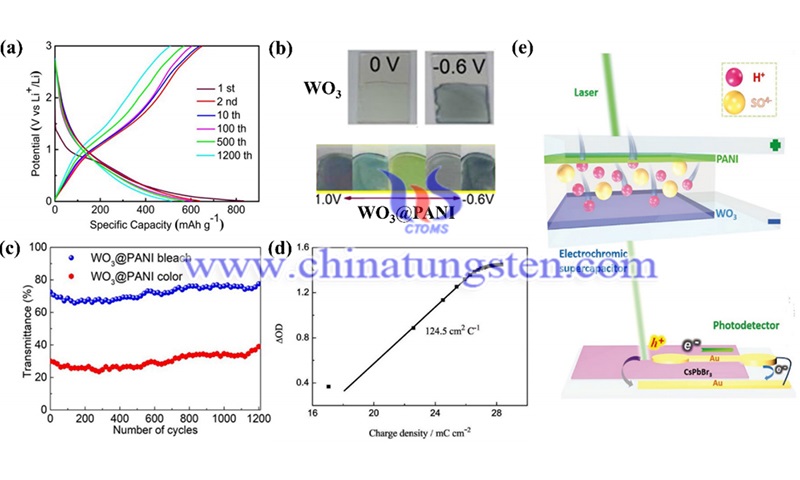Tungsten Oxides Based Electrochromic Energy Storage Devices
- Details
- Category: Tungsten's News
- Published on Monday, 13 February 2023 21:40
In the application of electrochromic energy storage devices, the methods to improve the bifunctional properties of tungsten oxides electrodes are very similar to those used to improve electrochromic and energy storage properties: obtaining porous nanostructures, doping, and integrating tungsten oxide with other materials, especially organic materials. In most cases, these methods are not used individually, but two or three methods are used simultaneously.
Nanostructures can greatly facilitate the electrochemical activity of electrodes. For example, by hydrothermal method, He et al. fabricated different tungsten oxides nanostructures, including nanoshafts, nanometals, nanosheets, and nanobricks. Among them, the nanosheets have better electrical conductivity, including wider optical contrast, faster switching speed, higher coloring efficiency, and capacitive properties with larger area capacitance due to their significantly increased active sites, and facilitated diffusion of Li+ ions through large surface area and porous structure. Soon after, his research group achieved WO3-H2O nanosheets by a one-step citric acid-assisted hydrothermal method that does not require a seed layer at a relatively low temperature of 90◦ C.
![]()
The film possesses a large light modulation of 79.0% at 633 nm and a high area capacitance of 43.30 mF cm-2. When the film is fully charged, its color turns blue. Wang et al. fabricated a mesoporous WO3 film by a template-assisted sol-gel method. It has a faster switching time and higher storage capacity compared to microporous WO3 films due to the reduced diffusion length and more exposed active sites in mesoporous WO3 films. Later, the researchers also made neodymium-doped WO3 mesoporous cathode films by sol-gel method.
The results show that slight Nb doping gives the films a wider light modulation range, shorter switching speed, and higher capacitance, as the introduction of Nb elements is accompanied by the introduction of O vacancies, increasing the conductivity of the electrodes. Other studies report that Mo-doped WO3 films with amorphous and porous structures can provide more channels and active sites for fast ion transfer and redox reactions.
Many organic materials with large energy storage capacity and outstanding electrical conductivity are also good candidates for electrochromic (EC) materials and have colorful color changes upon voltage changes. When inorganic and organic materials are integrated together, some synergistic effects occur. As an inorganic material, tungsten oxide has high electrochemical stability and long cycle life, but poor electrical conductivity. When previously organic materials are integrated with tungsten oxide, the final properties of the composite can be improved and the weaknesses of the single component can be weakened. For example, the monochromatic display problem of tungsten oxide can be solved.

In electrochromic energy storage devices, one of the more popular integrations is to incorporate a material that can form a donor-acceptor system with tungsten oxide, based on the fact that tungsten trioxide is an n-type semiconductor. It has been reported that this donor-acceptor pair can have a strong binding force, and therefore, the composite is very stable, so the composite may have a long lifetime. On the other hand, ion, and electron transport are facilitated. In addition, the voltage window of the composites can be expanded due to the introduction of organic materials. Many researchers have designed new donor-acceptor pairs.
Wei et al. electropolymerized polyaniline (PANI) onto the surface of tungsten oxide to form nanocomposites. They observed that the oxidation peak current in the CV curves of the nanocomposites was significantly reduced compared to that of pure PANI due to the presence of the donor-acceptor system. The results indicate that the nanocomposite not only has a higher color efficiency (98.4 cm2 C -1) than the pure tungsten oxides film (36.3 cm2 C -1) and the pure PANI film (50.0 cm2 C -1), but also has a more stable cycling performance. In addition, the nanocomposite has a wider potential window than pure PANI.
In addition, as the voltage changes, the composite material shows purple, green, yellow, gray, to blue. Other organic materials have been added to this similar system. Some researchers have prepared composites of WO3 and poly (indole-5-carboxylic acid) (P5ICA), where P5ICA is a p-doped material, and nanocomposites of WO3 and poly(5-formylindole) (P5FIn), where P5FIn acts as a p-doped semiconductor. Both composite electrodes show high capacitance and good cycling stability.
Reference: Han W, Shi Q, Hu R. Advances in electrochemical energy devices constructed with tungsten oxide-based nanomaterials[J]. Nanomaterials, 2021, 11(3): 692.
- Tungsten Manufacturer & Supplier, Chinatungsten Online: www.chinatungsten.com
- Tungsten News & Prices of China Tungsten Industry Association: www.ctia.com.cn
- Molybdenum News & Price: news.molybdenum.com.cn
- Tel.: 86 592 5129696; Fax: 86 592 5129797; Email: sales@chinatungsten.com



 sales@chinatungsten.com
sales@chinatungsten.com